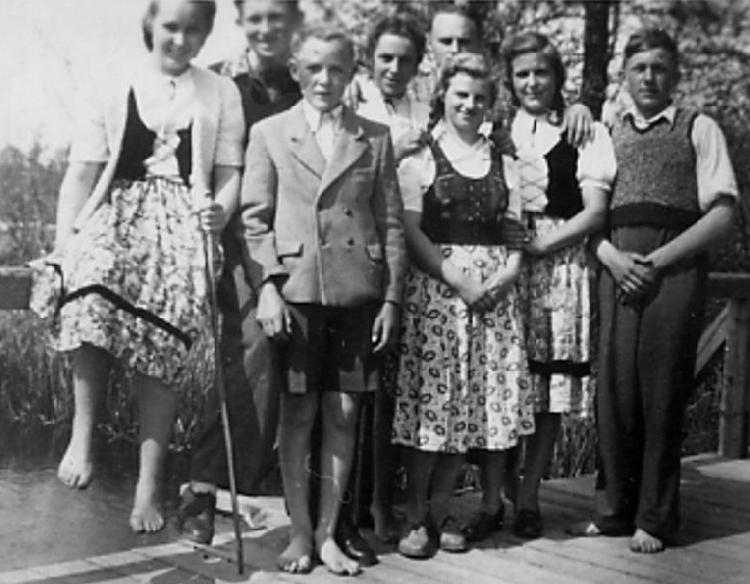
Ethnic Clothes: Female German Costumes

Figure 1.--This photo was taken in the early-1950s in Wusterwitz, during a country outing. Wusterwitz is a municipality in Brandeburg, at the time part of East Germany. For some reason the girls wear Drindl folk dresses, but ther boys do not wear Tracht. It may have something to do with East Germany and Communist/Soviet concern wih German nationaism. Availability may be another factor.
|
|
German women and girls also wear a variety of ethnic outfits. The principal item is the Dirndl. The Dirndl is a type of dress once commonly worn throughout Bavaria and Austria. After World War II it became morea style worn for special occassions.
The proper term for the dress is Dirndlkleid. The origins of the term is that 'Dirndl' in Alpine regions is a diminutive for 'woman'. It is still occasional heard although now increasingly obsolete. It was originally a peasant or country dress as opposed to the more refined, fashionable dress of the cities. And because maids were recruited from the peasantry, it also became seen as a maid's dress. Germany began to change as after the Napoleonic Wars
and the Industrial Revolution took hoild (mid-19th century). Many Germans who had moved to the city began to become nostalgic about their rural roots. Well-to-do urban Germans started adopting the Dirndl as holiday wear in the countryside. Ant they began to have their children photographed in folk outfits. The girls wore Dirndles and the boys Lederhosen and other Tracht gaerments. These garments by the turn-of-the 20 century had become a kind of emblem of German heritage. There were a wide variety of Dirndles with variations often regionally based. There were, however, some common elements. The bodice of a classic Dirndl is typically low-cut with a squared neckline. They were not as revealing as modern examples, but certainly more revailing than other 19th century garments. The blouse-like bodice is commonly tight and either sleeveless or short, baloon sleeves. There was often a coloful vest-like adduition. The skirt part of the Drindl is both long and full. The short modern Drindl sometimes seen today are not authentic. The skirt flares out from the tight bodice--a dramatic characteistic of the Dindl. An apron is often added to stress the rural peasant origins.
here are many regional differences. One example is Allgäuer style. The woman's Festtracht exemplifies the traditional simplicity of the area. We wear: a gray skirt (about 16 rows of gathering---the way this skirt is gathered typifies the Allgäuer style) , a white Trachten blouse, a black Mieder, a Allgäuer Hat with feather (worn on the crown of the head) , a red apron, a single red flower Trachten Shoes (white or black hose).
HBC

Navigate the Boys' Historical Clothing Web Site:
[Return to the Main German ethnic gender costume page]
[Return to the Main German ethnic costume page]
[Return to the Main German page]
[Return to the Main lederhosen page]
[Introduction]
[Activities]
[Biographies]
[Chronology]
[Clothing styles]
[Essays]
[Bibliography]
[Contributions]
[FAQs]
[German glossary]
[Images]
[Links]
[Registration]
[Tools]
[Boys' Clothing Home]
Navigate the Boys' Historical Clothing ethnic pages:
[Main ethnic page]
[German]
[Greek]
[Irish]
[Native American]
[Scottish]
Created: 1:24 AM 12/21/2010
Last updated: 1:24 AM 12/21/2010



